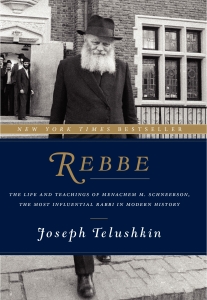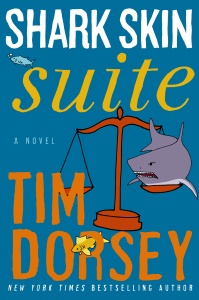Rebbe: The Life and Teachings of Menachem M. Schneerson, the Most Influential Rabbi in Modern History, by Joseph Telushkin. Harper Wave. 640 pages. Hardcover $29.99.
This is an excellent and highly original biography, one that exhibits a mature balancing of courage, judgment, and shrewdly managed resources. It comes to us at a time in which other ambitious biographies of Rabbi Schneerson have also appeared. Though I’ve only glanced at the others, my sense is that this one provides the most rounded picture.
How is Telushkin’s treatment original? The author made the provocative decision to organize his material by topics rather than by chronology. The first ten parts of the book, each part except two divided into two or more chapters, move readers steadily across a panorama of ideas, values, skills, personal traits, objectives, and achievements. Some examples of chapter titles are: “Connecting to Individuals,” “Expressing Disagreement Without Being Disagreeable,” “There Also Needs to Be a Girl,” “When Is It Wrong to Make Aliyah,” “United States: Prayers in the Schools, Menorahs in the Streets,” and “Mrs. Schneerson from President Street.”
The eleventh part, at long last, is “The Life of Rabbi Menachem Mendel Schneerson,” which is called by Telushkin “A Timeline Designed to Be Read” – and so it is. I’d love to see these sixty pages reprinted as a separate pamphlet.
Essentially, however, Rebbe is a collection of pointed, carefully sequenced anecdotes that require seventy pages of endnotes to substantiate.
In one way or another, most of these vignettes reveal Rabbi Schneerson’s kindness, practical and scholarly wisdom, and unassuming performance as an exemplary figure. Many of the stories show him in action guiding the movement that would become one of the greatest religious outreach efforts ever. The inclusiveness of Schneerson’s Chabad vision rests on the belief that every Jew is important; indeed that all individuals are made in God’s image and thus all are important.
The Chabad strategy, which operates worldwide, depends on the hard work of saving one Jewish soul at a time, enlarging the opportunity and longing for meaningful Jewish identity, and providing the foot soldiers – the young Chasidic couples who take their postings to the most remote and most Jewishly sparse locations as fortunate assignments. Telushkin’s stories about these emissaries makes the energy and warmth of Chabad Centers come alive.
The author also makes clear that The Rebbe redesigned his transplanted community for the later twentieth century America to which he and so many other Jewish leaders and followers had come in the double-wake of the Holocaust and Soviet repression. Movement headquarters in Crown Heights might show signs of Old World fashion and insularity, but from it Rabbi Schneerson and his aides generated a highly dynamic, technologically current program that could reach out to and affect the diverse Jewish population.
Because of his sense of mission, The Rebbe found an argument that made the traditional grand mitzvah of Aliyah take second place. He never encouraged Aliyah when it meant a needed leader would weaken his community by moving to Israel.

Telushkin
Many other positions of the great leader were controversial. Among these was his insistence that graduates of Chabad schools (and perhaps Orthodox-leaning young adults in general) should not go on to college. Well, at least not right away. Telushkin understands this negative advice as a recognition of the seductive power of secular culture. People in their late teens and early twenties were still so unformed; why not wait – and learn – within protected religious walls before risking exposure to that seduction?
The Rebbe was a consummate advice giver. He advised politicians, business leaders, and senior Israeli officials – including high-ranking military officers. His own secular studies in science and engineering had sharpened his analytical skills, perhaps even more than did his yeshiva studies in Torah and Talmud. He kept abreast of local, national, international news, forming reasoned and persuasive opinions. It may seem strange to say it, but Telushkin conjures The Rebbi as a man of the world who rarely left home.
His late night to early morning meetings with seekers, most often private meetings, brought all kinds of people through the doors of Chabad Central. All seemed to leave transformed in some way. The Rebbe was quick to understand their situations and needs. With kindness and firmness, his could suggest how difficulties were opportunities and hint at fruitful directions for the seeker’s future. For thousands of Jews, one of those nighttime meetings with Rabbi Schneerson was something like a Catholic’s audience with the Pope, though probably even more life-changing. Menachem Mendel Schneerson knew how to listen.
Author Telushkin records many such meetings, and he keeps readers amazed at much of Rabbi Schneerson’s time – the time that most people would be sleeping – was occupied with these one-on-once sessions.
Telushkin takes on the big questions: the nature of the Chabad movement’s messianic outlook, especially as it applies to the near-anointment of The Rebbe; the family fracture when he was selected to be his father-in-law’s successor that revealed itself in the consequent crime of his wife’s nephew stealing books from Chabad’s rich library of rare treasures; and his attitudes toward evolution and toward the heliocentric planetary system.
And don’t think this is some dull, pedantic shuffle of research notes and sycophantic adulation. There is plenty of edgy material in this tome. Every page is alive with fascinating information and – yes – revelation.
Joseph Telushkin captures the greatness and the vibrant humanity of an exceptional leader whose leadership, though not his life, is ongoing. He allows us an abundance of glimpses at this childless man who was a spiritual father to the many people who knew him and to the many more who didn’t. In a voice at once sturdy and flexible, Joseph Telushkin justifies and adds to the very high esteem he has earned in his long career as a premier Jewish scholar for the educated masses.
This review appears in the March 2015 issue of Federation Star (Jewish Federation of Collier County), L’Chayim (Jewish Federation of Lee and Charlotte Counties), and The Jewish News (Jewish Federation of Sarasota / Manatee).
 Gorgeously frightening, astonishingly creative, and ready to be a cult classic, Robert Levy’s debut novel,The Glittering World, creates a world so complete that it seems only too real. Or is that world the natural one and the world we know the distortion? Certainly on a psychological level, it is shockingly real. Four characters set out on what seems to be a simple and practical mission, but end up in a world of torment, discovery, and heightened awareness.
Gorgeously frightening, astonishingly creative, and ready to be a cult classic, Robert Levy’s debut novel,The Glittering World, creates a world so complete that it seems only too real. Or is that world the natural one and the world we know the distortion? Certainly on a psychological level, it is shockingly real. Four characters set out on what seems to be a simple and practical mission, but end up in a world of torment, discovery, and heightened awareness.









